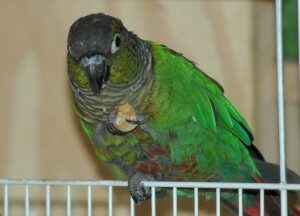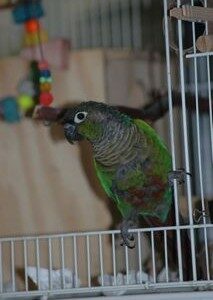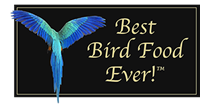This is the fifth of seven articles that chronicle the details of this precious bird’s healing process.
In sharing this information with you I ask you to acknowledge along with me that parrots are intelligent, sentient and self-aware individuals capable of feeling a wide range of human-like emotions.
Using a Holistic Approach for Healing Feather Destruction
I next explained to Elvis that if the results from his blood work indicated he was free of contagious diseases he would probably be able to join the rest of my flock in our living room very soon.
Later that day I learned that his fecal exam indicated he had a gram negative bacterial infection. Instead of using antibiotics as suggested by my local avian veterinarian, I consulted with my holistic avian veterinarian who put together a specific nutritional supplement blend to promote his body’s natural abilities to heal this bacterial imbalance from the inside out.
A few days later his blood results indicated that he tested negative for psittacosis, giardia, and polyoma. Although I usually quarantine a new avian arrival for at least one month, and sometimes two, my local avian veterinarian and I agreed that it would be safe for the rest of my flock, and best for Elvis, if he came out as soon as possible. He began his new life with a new cage and was elated to join the rest of my feathered family. x

x
Space being limited in my present home, Elvis’ new cage is located where he can easily look into the kitchen and watch me prepare food, both mine and his. One morning I accidentally discovered his favorite food. As I brought the three containers holding nuts out of the bird cabinet he watched me intently. When I open the container filled with walnut pieces he began quivering with anticipation and the excitement of recognizing a food he had not seen in a very long time.
x
“I never thought I would ever taste those again!” Was the message I received from him. Who ever had weaned him taught him to eat a healthy variety of foods.
As Elvis continued adjusting to his new life with me his feathers had grown in very nicely. However, he had an very low threshold to change of any type. If I had to alter our regular schedule, or I missed play time with him he became stressed. If I refused to let him bully me into submission and rip holes in my clothing, like he had done with his previous caretakers, he would express his stress by pulling out a few chest feathers.

Since this was the behavior I wanted to help change I ignored it. Instead, I calmly talked with him and explained why the change in our routine was necessary. Then every time I knew there would be a change in our schedule I talked with him about it ahead of time. This made a huge difference. He easily began accepting my picturesque explanations and stopped pulling feathers when changes to our anticipated routine occurred.
I was beginning to teach Elvis how to tolerate and accept change. Any well socialized parrot approaches interesting and new experiences gracefully, with curiosity and interest. Elvis had acquired a strong belief that any type of change meant something was drastically wrong. Together we were working to alter this perception.
x
For part 6 in this series, read how a holistic approach began helping Elvis.
Follow this link:
This article originally appeared in its entirety in the August 2007, issue #115, of Parrots magazine. Subscriptions to Parrots magazine are available on-line at www.parrotmag.com .
Did this post provide you helpful information? Do you have questions? Please send us a comment.
x
x







